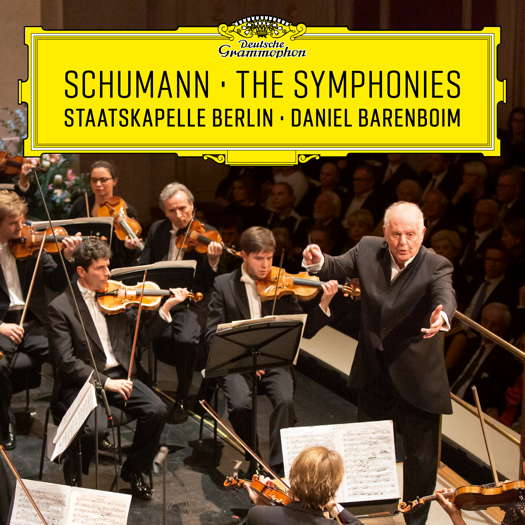- Smetana
- Susan Chilcott
- Czech Philharmonic
- Herod the Great
- paladino music
- Reinbert de Leeuw
- Delyana Lazarova
- The Noonday Witch

Passionate Lyricism
GERALD FENECH listens to Daniel Barenboim conducting Schumann's symphonies
'... dazzling music-making that sweeps you off your feet.'
Even today, the symphonies of Robert Schumann (1810-1856) continue to occupy an exceptional position in the history of musical interpretation. While no-one would deny that they are a part of the core repertory of major orchestras and conductors, they are much less often performed and recorded than the Brahms set, to say nothing of the towering presence of Beethoven, especially his Ninth. It is a fate they share with the symphonies of Schumann's friend and colleague Felix Mendelssohn. And the reasons for it are not hard to find. From an early date, Schumann's critics found fault with his handling of the orchestra, claiming that it failed to do justice to the technical improvements in instrument-making in the nineteenth century, and did not exploit the enormous range of tone colours that had now become available. Schumann's sound - the critics claimed - was too undifferentiated, even monochromatic, with the result that his instrumentation needed retouching, which is exactly what one of Schumann's admirers, Gustav Mahler, was to do to his First Symphony later in the century.
A second fatal argument was also adduced by no less a composer than Richard Wagner, who argued that Schumann's gifts were limited, and that he had the presumption to attempt to do something for which those gifts were simply inadequate, namely create bolder large-scale forms. When seen from this perspective, Schumann appears to represent a stylistic compromise that met the aesthetic demands of a prosperous but politically frustrated bourgeois public. What Wagner failed to mention was the rich inner life that lay concealed beneath the neoclassical surface, and how much he himself had profited from this. In their own attempts to bring the symphony and the symphonic poem into closer alignment, Franck and Tchaikovsky both appealed directly to Schumann. To borrow a phrase from Nietzsche's Thus Spake Zarathustra, we could say, therefore, that Schumann's symphonies are aimed 'at everyone and at no one'.
The First Symphony in B flat, Op 38, known as the 'Spring Symphony', is Schumann's first completed symphonic work. Until 1841 the composer was largely known for his piano works and 'lieder', but his wife Clara encouraged him to go further. And so he did. Schumann sketched the work in four days, from 23 to 26 January, and by 20 February the orchestration was ready. The premiere took place under the baton of Felix Mendelssohn on 31 March 1841 in Leipzig, where the piece was warmly received. The symphony is full of light and joy and conveys perfectly the longing for spring and the awakening that this season brings with it. Indeed, from the very first trumpet call to the last note, the work is consistently alive with the throb of life reborn.
Listen — Schumann: Andante un poco maestoso (Symphony No 1)
(00028948629589 CD1 track 1, 0:01-0:55) ℗ 2022 Daniel Barenboim:
Symphony No 2 in C, Op 61 followed four years after Schumann had for the moment put aside his second mature attempt at the form, later to be revised as Symphony No 4 in D minor. The work was sketched within a fortnight in December 1845, bringing to an end a period in which the composer's depression had hardly been improved by the move to Dresden. He completed the orchestration during the following year, his task prolonged by the recurrence of nervous exhaustion. It was performed at the Gewandhaus in Leipzig under Mendelssohn (again) on 5 November 1846, and received more warmly at its second performance there eleven days later in a slightly revised version. This Symphony is less programmatic than much of Schumann's work, but it reflects to some extent his psychological state and his struggle against melancholy. The introduction to the first movement contains elements developed symphonically in what follows. There is a busy 'Scherzo' with two contrasting 'Trios' and a movingly sombre 'Adagio', followed by a final answer to despair that brings to an end Schumann's most symphonic symphony.
Listen — Schumann: Allegro molto vivace (Symphony No 2)
(00028948629589 CD1 track 8, 7:04-8:03) ℗ 2022 Daniel Barenboim:
After living in Saxony for the first forty years of his life, in 1850 Schumann accepted the post of Music Director at Dusseldorf on the banks of the Rhine. The exuberant welcome from the locals in September inspired the composer to one of his most productive and optimistic periods. After dashing his Cello Concert in only fifteen days and conducting the first of ten subscription concerts, he composed his cheerful third and last symphony, the 'Rhenish', in E flat, Op 97, in only five weeks, completing it on 9 December 1850. The fourth preceded it but was published after the Rhenish, so the sequence got inverted. There is a generally sunny mood in this symphony, and the music vividly reflects Schumann's initial happiness in his new environment. In five movements - the other three are all in four - the work opens with a movement dominated by a lively theme accentuated by cross-rhythms. The following Scherzo is a relaxed country dance. The lyrical intermezzo that follows is led by winds and horns over accompanying strings. The fourth movement, based on a solemn trombone chorale, is a tribute to the massive structure that is Cologne Cathedral and all it represents.
Listen — Schumann: Feierlich (Symphony No 3)
(00028948629589 CD2 track 4, 0:00-0:43) ℗ 2022 Daniel Barenboim:
The final movement opens with a simple, cheerful melody. As the orchestration gradually thickens, the movement's role as an extension of the 'cathedral music' becomes more apparent, until a thrilling coda brings the symphony to an exhilarating close. The Rhenish was premiered on 6 February 1851 in Dusseldorf with the composer conducting. The work in general was enthusiastically received, and remains to this day Schumann's most popular symphony.
Schumann wrote the first version of his Symphony No 4 in D minor, Op 120 in Leipzig during the early months of his marriage to Clara Wieck in 1840, calling it 'my Clara Symphony', but put it aside after the cool reception it received at its first performance in December 1841, in a programme shared by Liszt who dazzled and overwhelmed the audience to the exclusion of all else. The composer revisited it in 1851, and conducted the first performance of this second version in Dusseldorf on 30 December 1852, rejecting his first title of 'Symphonic Fantasy' in favour of orthodoxy. There is a certain thematic unity in the work deriving largely from the first theme of the first movement, which reappears in the slow movement and in the Trio of the 'Scherzo'. The opening movement has no recapitulation, but moves after the development with its new theme to the Romance. The Scherzo has two trios and is linked to the slow introduction to the final movement with its initial dark-hued reminiscences of the opening of the work giving way to the cheerful variety of its energetic conclusion.
Listen — Schumann: Langsam - Lebhaft - Presto (Symphony No 4)
(00028948629589 CD2 track 9, 6:38-7:33) ℗ 2022 Daniel Barenboim:
To say that these works are close to Barenboim's heart is an understatement. When the maestro recorded these symphonies way back in 2003 with the same orchestra they were enthusiastically received. This latest foray into Schumann territory should garner even higher praise. Indeed, Barenboim delivers immensely detailed interpretations that are engaging throughout. The music is consistently revelatory, and Schumann is presented for what he really is, a true melodic and original genius. Staatskapelle Berlin responds with electrifying ardour while letting the music flow with warmth and grace, and when warranted, Schumann's passionate lyricism is brought out with singular conviction. This is dazzling music-making that sweeps you off your feet.
Copyright © 18 October 2022
Gerald Fenech,
Gzira, Malta

CD INFORMATION - SCHUMANN: THE SYMPHONIES




